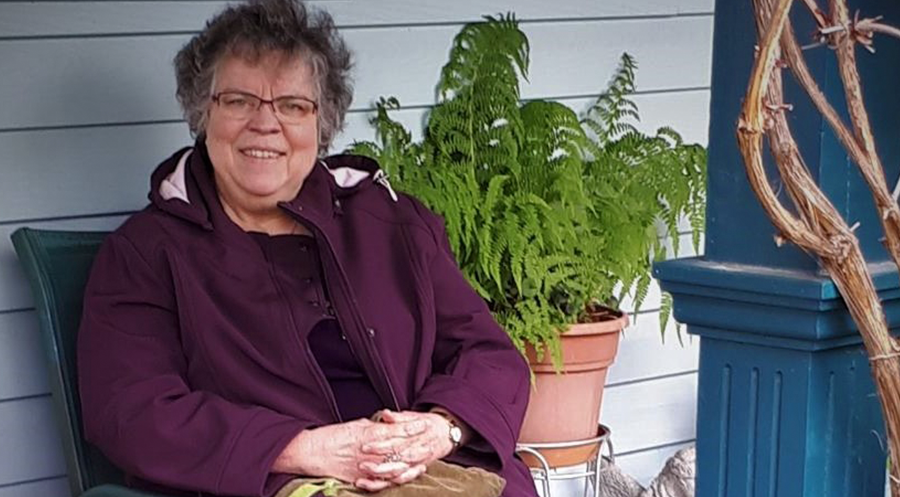
“I came from a culture where you don’t talk about your health; I was raised to believe that this was complaining, and it was especially true for women.”
Jennifer was born in Jamaica, earned a diploma in Business and moved to Canada in 1971. She worked in Montreal and enrolled as a part-time student at McGill University. Two years later, she continued her studies at Western University in Ontario, followed by Mount Royal College in Calgary. While in Calgary, she wed her husband – married now 48 years with four children. She later returned to University to study social work.
Around 2006, she started to experience changes in her heart’s rhythm.
“My heart seemed to be pounding, often up into my neck. It was difficult to take a deep breath, but I had no pain. I thought it was menopause or increased stress as I had a stressful job in a stressful environment at the time. My arrhythmia issues would stop as suddenly as they started – sometimes for several weeks. Then they would suddenly return, often causing me to feel dizzy and lightheaded. I felt like I was having an out-of-body experience, as though my brain was not connected to my body. I had increased anxiety because I couldn’t breathe deeply and sometimes had difficulty swallowing.”
On four different occasions in the span of 1-year, Jennifer accessed the emergency department (ED) by ambulance for her irregular heartbeat and increased breathlessness. Once she got there – like magic – her heart’s rhythm would return to normal. Multiple physicians told her to try relaxation methods and meditation. This made her chuckle because she already practiced mindfulness meditation and relaxation to relieve her nerve pain.
One particular incident was quite frightening and memorable.
“I was at home, and I couldn’t breathe deeply. My heartbeat was erratic, and my head and right eye were throbbing. I felt increasingly anxious. My daughter was visiting, and she called an ambulance. When they arrived, they checked my heart rhythm and immediately called for advanced life support. I kept thinking there was nothing really wrong with me. I just can’t breathe that well. The paramedic told me my heart was beating at 230 beats per minute. They treated me with adenosine and took me to the ED.
Again, when we arrived at the ED my heart settled back to normal. The physician who examined me did not perform any tests, did not refer me to a cardiologist and sent me home. As I was leaving the ED, the paramedic who had brought me in saw me and asked why I was leaving. I said that the doctor told me that everything was clear and I remember him looking at me quite horrified.
A few days later, I called my General Practitioner (GP) and asked her to refer me to a cardiologist, and she did. After seeing the cardiologist and several tests later, I was diagnosed with supraventricular tachycardia (SVT).
I received my first ablation in 2011, followed by another in 2014. I have also been diagnosed with Preventricular Contractions (PVCs), and recent tests confirmed increased arrhythmia issues. Now, I take it one day at a time. I walk daily from 30 to 40 minutes and keep busy with house chores, hobbies, and volunteering.”
Jennifer is involved with CANet as a VIRTUES Patient Working Group member and provides feedback on educational materials, infographics, videos, etc. She’s also active in her province, participating with the BC provincial Virtual Health Practice and Education Working Group and participating in research with ReachBC. In addition, Jennifer has partnered with the BC nursing program to guide, from a patient’s perspective, how to communicate with patients and their families. Most recently, she’s been a Patient Partner with Western Communities Primary Care Network Operations Committee on Vancouver Island.
“I always remind myself that I volunteer first because it makes me feel good about myself, and I’m sharing with the hope of improving outcomes for others. I strongly believe that we empower and learn from one another. I also volunteer because I learn and better understand people’s experiences. I believe that patient involvement improves project and research outcomes because researchers have the opportunity to look at things from a patient perspective. Care is a two-way street. Whether you’re making the machines or on the other end of hands-on care, both needs must be met. Having a voice in those developments is very important and can help create a safe space for better programming for patients and families that are ultimately more successful.
I also think for the people working in healthcare it’s important to have the support of patients and caregivers. Working together allows everyone to feel affirmed and for me, it’s good to see that there are people who really carea about what’s going on in our healthcare system. During our hospital visits, we don’t see the dedicated people who are working to improve care behind the scenes.”
In addition to her patient partner work, Jennifer advocates for reducing biases in healthcare.
“I feel that there is a bias against older women and people from different cultures. It’s often assumed that we are unclear about what’s going on. I know my body, and when something doesn’t feel right. I came from a culture where you don’t talk about your health; I was raised to believe that this was complaining, and it was especially true for women. My daughter always says, ‘Mom, you need to keep notes, emphasize what you’re actually feeling and describe your feelings as best you can.'”
Join and share your experiences on our members-only Facebook discussion group for our community of patients and caregivers, click here.
Subscribe to our Ticker Times newsletter, click here.